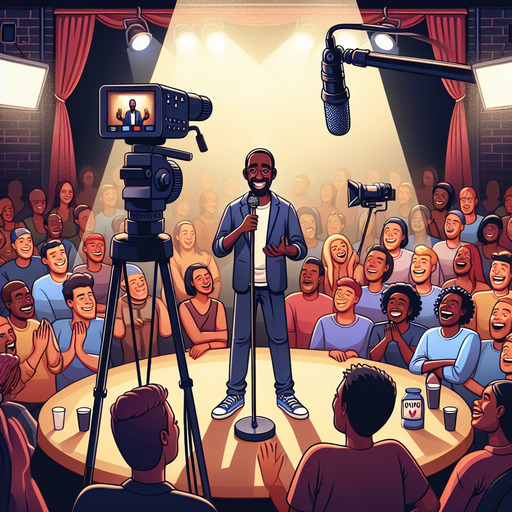
-
Table of Contents
Elevate your stand-up comedy game with expert video recording tips for live performances! Capture every laugh and perfect your craft. Learn more here.
Introduction
Stand-up comedy is an art form that thrives on live audience interaction, timing, and the unique energy of a performance. Capturing this dynamic experience on video requires careful planning and execution to ensure that the essence of the performance is preserved and conveyed to viewers. This guide provides essential tips for recording stand-up comedy live performances, covering aspects such as equipment selection, camera placement, audio quality, and post-production techniques. By following these tips, you can create high-quality recordings that effectively showcase the comedian’s talent and the audience’s reactions, making the viewing experience as engaging as being there in person.
10 Essential Tips for Recording Stand-Up Comedy Videos: From Filming to Editing for Viral Success
Recording stand-up comedy videos can be a challenging yet rewarding endeavor, especially when aiming for viral success. To ensure your live performance is captured in the best possible way, there are several essential tips to consider, from the initial filming process to the final stages of editing. By following these guidelines, you can create a polished and engaging video that resonates with audiences.
First and foremost, selecting the right equipment is crucial. High-quality cameras and microphones are essential for capturing clear visuals and crisp audio. Investing in a good DSLR or mirrorless camera, along with a shotgun microphone or lavalier mic, can make a significant difference in the final product. Additionally, using a tripod or stabilizer will help maintain steady shots, preventing any distracting camera shakes.
Once you have the right equipment, it’s important to consider the venue’s lighting. Proper lighting can enhance the visual quality of your video, making it more appealing to viewers. If the venue’s lighting is insufficient, consider bringing additional lighting equipment, such as LED panels or softboxes, to ensure the performer is well-lit. This will not only improve the video’s clarity but also highlight the comedian’s expressions and gestures, which are integral to the performance.
Positioning the camera is another critical aspect. Ideally, the camera should be placed at eye level with the performer, capturing a clear view of the stage. A wide shot that includes the audience can add context and showcase the crowd’s reactions, which are often a vital part of the comedy experience. However, it’s also beneficial to have a secondary camera for close-up shots, focusing on the comedian’s facial expressions and body language. This multi-camera setup can provide a more dynamic and engaging viewing experience.
During the performance, it’s essential to monitor the audio levels continuously. Comedy relies heavily on timing and delivery, so clear audio is paramount. Using headphones to monitor the sound can help detect any issues in real-time, allowing for quick adjustments. Additionally, recording audio separately using a digital recorder can provide a backup in case of any technical difficulties.
After the performance, the editing process begins. Start by reviewing all the footage and selecting the best takes. Editing software like Adobe Premiere Pro or Final Cut Pro can be invaluable tools for this stage. When editing, aim to maintain the natural flow of the performance, ensuring that the pacing and timing of jokes remain intact. Incorporating audience reactions can enhance the comedic effect, so be sure to include shots of the crowd laughing and engaging with the performance.
Adding captions can also be beneficial, especially for online platforms where viewers may watch videos without sound. Captions make the content accessible to a broader audience and can improve engagement. Additionally, consider incorporating branding elements, such as a logo or social media handles, to promote the comedian and encourage viewers to follow their work.
Finally, optimizing the video for online platforms is essential for viral success. This includes creating an eye-catching thumbnail, writing a compelling title and description, and using relevant tags and keywords. Sharing the video across various social media channels and engaging with viewers through comments can also boost visibility and encourage sharing.
By following these tips, you can create a high-quality stand-up comedy video that captures the essence of the live performance and has the potential to go viral. From selecting the right equipment to optimizing the final product for online platforms, each step plays a crucial role in achieving success.
Q&A
1. **Question:** What are some essential tips for recording a stand-up comedy live performance?
**Answer:**
– **Camera Placement:** Position multiple cameras at different angles to capture the performer and audience reactions.
– **Audio Quality:** Use high-quality microphones to capture clear audio from the performer and the audience’s laughter.
– **Lighting:** Ensure proper lighting on the performer to avoid shadows and maintain visibility.
– **Stabilization:** Use tripods or stabilizers to avoid shaky footage.
– **Audience Shots:** Include shots of the audience to capture their reactions and enhance the viewing experience.
– **Editing:** Edit the footage to maintain pacing, cut out any dead air, and enhance comedic timing.
– **Backup:** Always have backup equipment and recorders in case of technical failures.